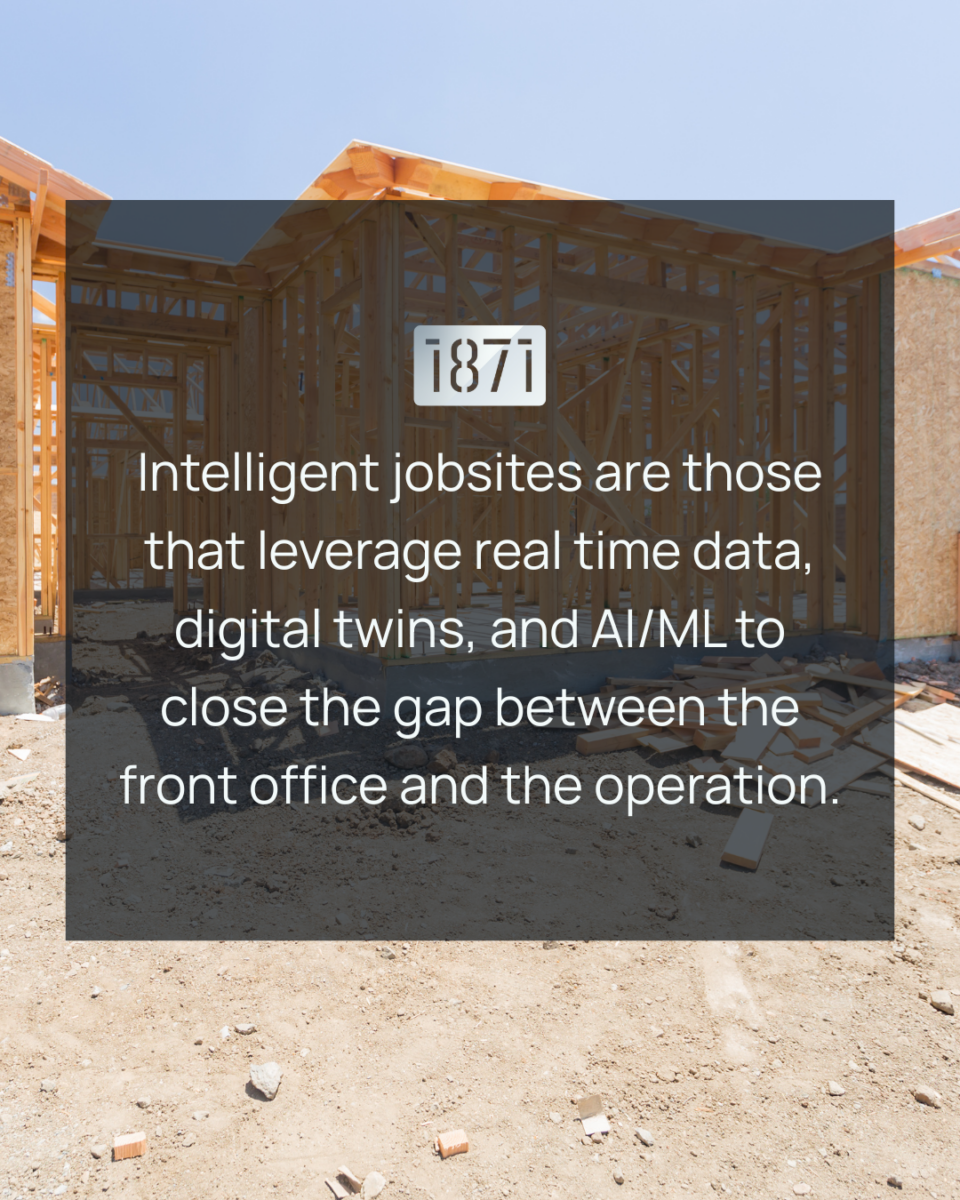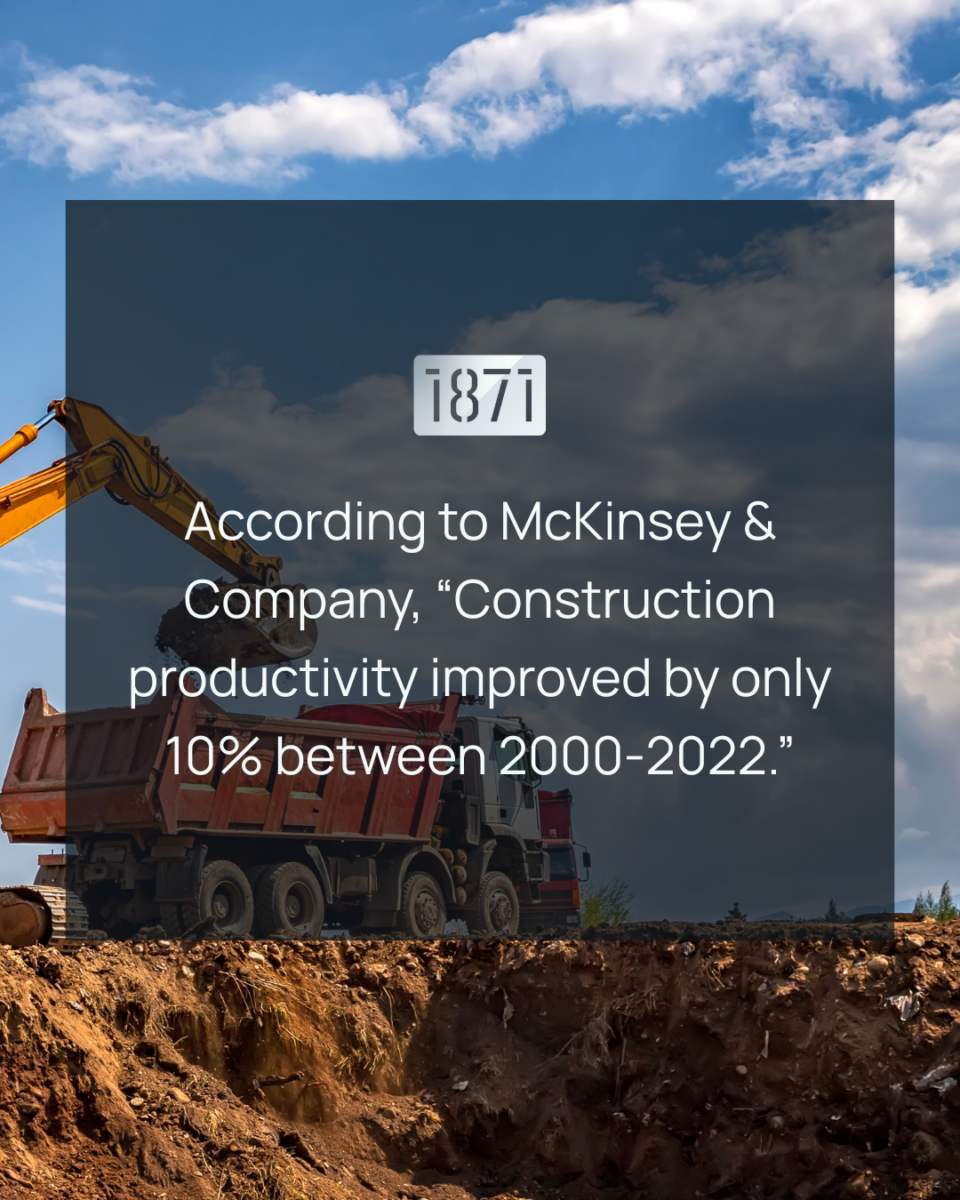Written by Jack K. Dunn
What are intelligent jobsites and why are they no longer optional for construction companies looking to compete in the modern construction market? Intelligent jobsites are those that leverage real time data, digital twins, and AI/ML to close the gap between the front office and the operation. According to McKinsey, “construction productivity improved by only 10% between 2000-2022, vs. a 50% productivity improvement of the total economy and 90% productivity improvement for the manufacturing sector for the same period”. This lack of progress highlights an available opportunity and demonstrates why intelligent jobsites are not optional, but instead, foundational to measuring what have traditionally been lagging indicators, such as jobsite productivity, jobsite costs, project progress, and overall profitability. To be positioned to win in construction, one must understand the reality of how non-tech enabled jobsites are managed, how technology can transform the jobsite, the barriers companies face in adopting this new technology, and finally, what is coming next. Ultimately, whoever solves the disconnected jobsite and closes the gap between the front office and the operation through real time data, AI/ML powered analytics, and digital twins, will win.
Non-tech enabled jobsites are plagued by inefficiencies, disconnected data points, miscommunication, and wasted spend. A typical non-tech enabled jobsite functions as follows: project managers estimate budgets and timelines with spreadsheets and phone calls, jobsite superintendents assign work in morning huddles through paper logs or whiteboards, materials and equipment are moved and ordered reactively as they are needed by the superintendent or procurement teams, supervisors track project progress manually with walkthroughs, and lastly, leadership teams in the front office receive weekly or even monthly reports to track jobsites costs, jobsite productivity, project progress, and overall profitability. It is not uncommon for the leadership team in the front office to not even know whether they are making money or losing money throughout the duration of the project.
There is a tremendous opportunity for companies to level up their operation by creating intelligent jobsites, but what does this actually look like? The first gap to be closed to enable an intelligent jobsite is real time data. Real time data is exactly what it sounds like; information that was previously recorded manually, such as project progress, jobsite productivity, material management, and profitability, is tracked continuously. Real time data is exactly what it sounds like; information that was previously recorded manually, such as project progress, jobsite productivity, material management, and profitability, is tracked continuously.

This ultimately gives management visibility into key insights and enables course corrections before it’s too late. However, this real time data is only made available through technological advancements, IoT sensors, and OEM integration. The second gap to be closed, once data is being tracked, is making that data visible. Digital twins solve this by transforming real-time data into a live virtual representation of the jobsite. They close the visibility gap by bringing the front office directly to the jobsite, enabling management teams to actively monitor progress, people, and assets in real time5. The third gap to be closed is the synthesis of real-time data and digital twins into actionable insights. This is where AI/ML becomes essential. The massive amounts of data collected from jobsites are not useful unless managers understand what the data means and what actions they should take based on it. AI/ML plays a critical role by identifying patterns, predicting outcomes, and making recommendations that enable management teams to make informed decisions before issues escalate or opportunities are missed.
Real-time data, digital twins, and the use of AI/ML for analysis all help close the gap between the front office and the jobsite, but what barriers are preventing construction companies from executing on their intelligent jobsite dreams, and are there any companies successfully doing it? Pre-existing barriers have made it difficult for many firms to adopt this technology. Most notably, construction jobsites are notoriously fragmented: they almost always involve a mixed fleet of OEM equipment, multiple software platforms, each providing different data points, and several contractors working on the same site.

This variability makes it extremely challenging for one solution to aggregate everything into a single, unified platform. However, several startups have made meaningful progress, and some have gained legitimate traction. One notable example is Virtual Superintendent, a startup based in New Zealand. Acquired by John Deere in 2024 for an undisclosed amount, Virtual Superintendent has gained traction by “using geospatial and satellite data, intelligent machine tracking technology, and cost and production data feeds” to deliver “a clear picture of what’s happening on your site in real time.6” Virtual Superintendent still aims to serve all customers outside of Deere but it has currently only broken into its native New Zealand and Australian markets.
Lastly, what’s next for the intelligent jobsite? As more startups work to solve the challenges of the disconnected jobsite and as construction companies adopt it as part of their long-term vision, it will be critical for firms to invest in platforms like Virtual Superintendent to integrate and unify their data. Beyond investing in tools, companies must also commit to building a data-driven culture, one in which supervisors and employees understand the value of real-time information and actively engage with the systems to unlock their full potential.
In conclusion, intelligent jobsites are no longer optional for construction companies that want to remain competitive in today’s market. To succeed, firms must embrace real-time data, digital twins, and AI/ML to close the gap between the front office and the jobsite. Startups like Virtual Superintendent are helping lead this transformation and companies that want to win must not only adopt these technologies, but actively invest in them as strategic infrastructure.
References
McKinsey & Company. Reinventing Construction Through a Productivity Revolution. 2024. Accessed May 28, 2025. https://www.mckinsey.com.
Peter Olsen, Senior Product Manager – Jobsite Automation at John Deere, interview by the author, April 21, 2025
Peter Olsen, Senior Product Manager of Jobsite Automation at John Deere, interview by the author, April 14, 2025.
Kevin Very, Manager of Production Systems & Product Management at John Deere, interview by the author, April 15, 2025.
Dunn, Jack K. 1871 Innovation Labs: Independent Study on ConstructionTech. Conducted March–May 2025.
Virtual Superintendent. The Virtual Superintendent. Accessed May 29, 2025. https://www.thevirtualsuperintendent.com/.
Join as an 1871 Early Stage Member.
Attend info sessionSubscribe to our ICYMI newsletter.
Share this post:
